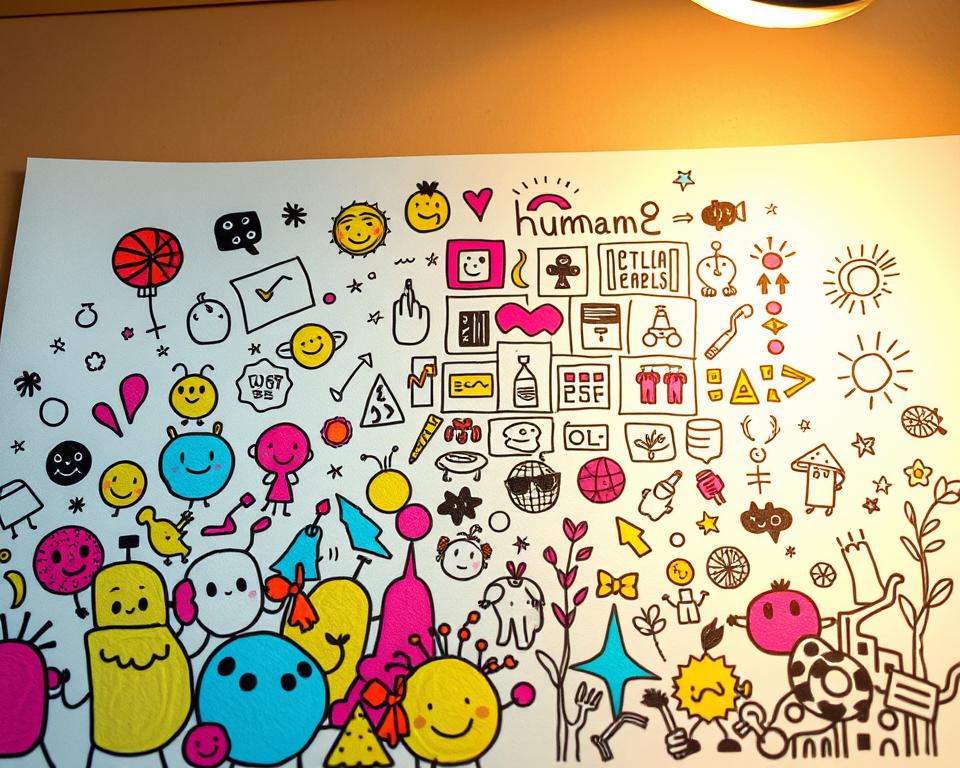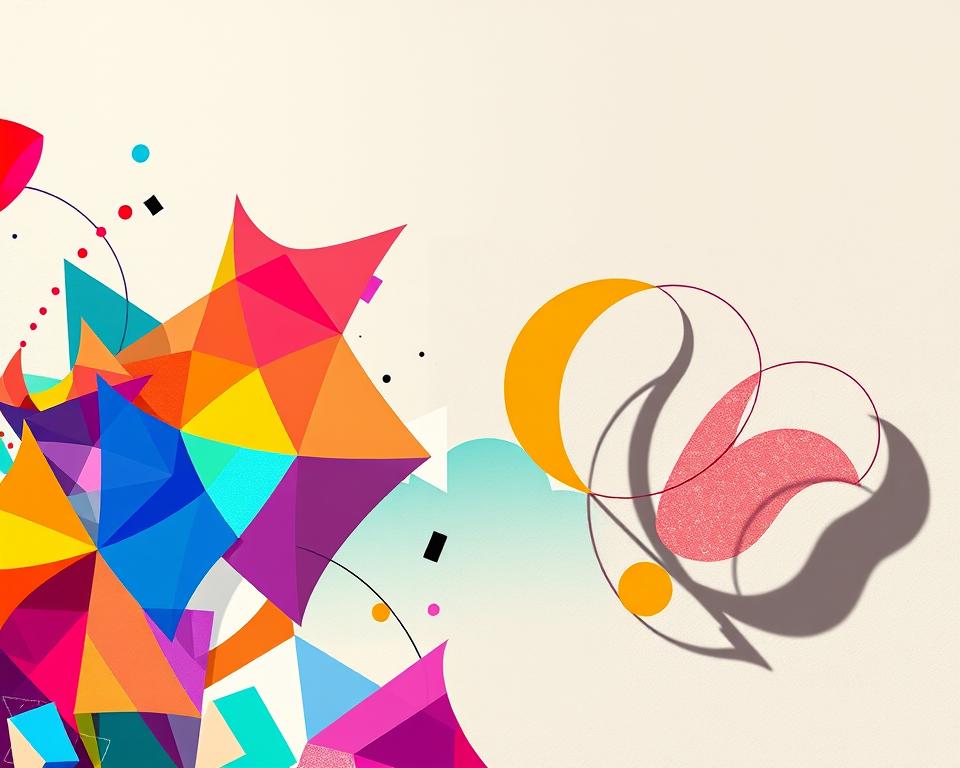Anúncios
creative trends 2025 show how design and technology are merging, and you need a clear view of what that means for your work today.
You’ll learn practical context, not promises. This introduction sets expectations: think strategic guidance you can test and iterate. See how major brands use AI in mockups and production, and how textured visuals and mass-media moments move attention and search.
We highlight real examples and data so your content, campaigns, and day-to-day production choices link to measurable signals. Expect advice on brand voice, accessibility, and tools that help you balance aesthetics with performance.
Use this as a living framework. Try small pilots, measure what matters, and scale what proves value. For broader industry views, explore a roundup from creative leaders’ predictions at creative leaders’ predictions.
Why creative trends 2025 matter now
Small design choices now decide whether your message earns seconds of attention. In a crowded feed, those seconds shape trust, recognizability, and action.
Anúncios
Attention, trust, and differentiation in a crowded media feed
Bold minimalism and textured grain are rising because they cut through fast scrolling and feel more human. Major stages like Adobe Max signal wider adoption, and DTC brands such as Poppi show how emotional creative can lift discoverability during big media moments.
- Win attention without clickbait: respect people and earn trust over time.
- Clarify your voice: consistent visuals help your brand compound recognition across placements.
- Measure what matters: scroll-stop, dwell time, and assisted actions over raw reach.
Balancing aesthetics with performance and accessibility
Design should serve users first. Consider color contrast, type size, and motion to reduce cognitive load.
- Balance visual flair with legibility across devices and lighting.
- Align teams on success metrics that value quality engagement, not just impressions.
- Revisit guidelines each year so your system scales with new formats and accessibility needs.
How we identified the year’s defining signals
We watch three lanes at once so you can see which trends are gaining real weight.
Anúncios
Triangulating brand moves, platform shifts, and cultural cues
First, we track notable brand executions. Work from Nike and agency portfolios like Superside shows how new workflows reach scale.
Second, platform cues matter. Showcases such as Adobe Max and UI updates often foreshadow what will feel native across content and media surfaces.
What early adopters tell you about diffusion and risk
Third, cultural moments reveal speed. Poppi’s Super Bowl spot created immediate search and sales spikes, showing how a single moment can change perception in a short time.
Map risk by testing audience reactions, production limits, and policy constraints before you scale a trend.
“Look for convergence: brand moves, platform changes, and cultural signals that repeat over time.”
- Log ideas and link observations to testable hypotheses.
- Use tools that speed iteration, but validate with user feedback.
- Run low-risk pilots with clear learning goals, not sweeping rebrands.
AI as your co-creator, not your replacement
Treat AI as a hands-on assistant that widens options and shortens cycles for teams today. This is a tool to speed parts of the process, not a substitute for judgment or brand stewardship.
Workflow realities: research, concepting, production, and mockups
Start with search and reference gathering to broaden direction fast. Designers use ChatGPT for naming sprints and taglines, and image search tools for mood boards.
In concepting, prompt alternates to explore style ranges. Curate outputs so they match your audience and brand standards.
During production, tools like Adobe Generative Fill speed cleanup and variations. Keep version control so you can retrace decisions and protect quality.
For mockups, Adobe Firefly and AI-generated scenes help you visualize packaging or out-of-home assets before you commit to full shoots.
Brand examples and what you’re seeing
Major brands and agencies are already testing AI-assisted workflows. Nike’s Neon concept used Midjourney plus Photoshop to iterate quickly, and agencies like Superside show avatar and campaign examples that maintain premium output.
Data supports adoption: 90% of creators report productivity gains with AI, and 76% of architectural and construction firms plan to adopt it in workflows.
Ethics, disclosure, and IP hygiene for responsible use
Build a short AI policy that covers disclosure, licensing, and data security. State when AI helped generate content and keep records of sources and prompts.
- Respect rights: verify licenses and avoid unlicensed training data.
- Guard bias and accessibility: test outputs with users for clarity and inclusivity.
- Document processes: track your tech stack, prompt libraries, and QA steps for repeatability and compliance.
“AI is a powerful assistant — use it to explore faster, but let human judgment decide what represents your brand.”
Bold minimalism: clarity with muscle
Pick a dominant element and let everything else step back so the message lands quickly. This approach favors one bold move per design — usually large type or a single striking image — to make your intent readable at a glance.
“One bold move per design”: type-led impact
Use big type as the anchor. Keep supporting copy short and scannable so the hero element carries the story in headers and simple ads.
Prioritize contrast and spacing. Test color pairs for WCAG contrast and size type so readers can scan across screens. Limit the palette to one anchor color and a secondary accent to reduce noise.
Use cases: product storytelling, ads, and headers
On product pages, pair a bold typographic claim with a crisp product shot so attention focuses on the core benefit.
- Anchor layouts with a single element — often big type — so the message reads fast.
- Use whitespace intentionally; space is the stage that lets the hero element perform across formats.
- When building ads, export variants with one shift (word, color, or crop) to A/B test what stops thumbs fastest.
Measure to validate. Track thumb-stop and view-through rates so boldness clarifies rather than confuses. Keep motion subtle — micro-animations on hover can add energy without breaking minimal aesthetics.
Maximalism returns with narrative density
When you want people to pause and explore, a “more is more” approach can turn a canvas into a story-rich experience. Use it where scale and narrative depth matter: hero installations, festival posters, and interactive pages that reward slow looking.
When to lean into immersive, layered work
Maximalism fits large canvases and cultural storytelling. Designers showed bold, illustrated work in Paris Olympics materials and Google’s interactive playground. Those examples use retro style, bright palettes, and layered detail to invite discovery.
Test first, don’t roll it out across everything. Reserve dense visuals for spaces where people can explore—hero sections, event installs, and long-form editorial pieces. Keep acquisition ads simpler so performance doesn’t suffer.
- Anchor complexity with a clear focal point so audiences are invited in rather than overwhelmed.
- Use a grid and consistent motifs to organize abundance and maintain craft across the composition.
- Plan production time and QA; layered pieces demand more coordination than minimal setups.
- Measure saves, shares, and qualitative feedback alongside clicks to judge whether the richness connects with your audience.
“Layered visuals and retro references let you build depth, but only when space and context let people explore.”
Textured grain and tactile depth in digital
A light noise layer can turn cold pixels into surfaces that suggest touch and warmth. Use grain with clear purpose so your visuals gain mood without losing clarity.
From flat to felt: grain for mood, movement, and warmth
You’re seeing grain return as a way to add warmth, motion, and tactile realism to otherwise flat digital surfaces. Designers apply this in museum flyers, festival banners, brand packaging, and editorial illustrations to create perceived depth.
Calibration tips: opacity, scale, and restraint
Start with a monochrome base and add noise at 10–15% opacity. If you can spot individual particles from arm’s length, dial it back—too much grain distracts.
Adjust scale so particles don’t dominate on lower-res screens. Calibrate across devices: what is subtle on a retina display can crush on older hardware.
- Use grain to unify composites and smooth gradients behind type and illustrations.
- Keep legibility first; avoid heavy texture beneath small text or UI controls.
- Localize effects with layer masks and presets in your chosen tool to protect focal content.
- Balance craft and performance: test file size and compression to keep load times healthy.
- Document texture tokens (scale, opacity, blending mode) so usage stays consistent in your system.
“Pair grain with solid color anchors so brand colors remain identifiable and accessible.”
Practical rule: use grain to enrich hero visuals, then dial back on functional surfaces. Restraint ensures depth enhances, not hinders, your design.
Unconventional color combinations that spark memory
A single dependable hue plus an unexpected pop can reset how people remember your visuals. Start by choosing an anchor color that reads clear across screens and print. Then add one surprising accent drawn from pairs you were told not to mix.
HAPPYWORK’s mint and coral shows how a grounded mint anchor lets coral sing without overwhelming the design. This approach leverages memory and category disruption while keeping usability in view.
Anchors and accents: why “wrong” can be right
Pick one reliable color for UI and layout anchors. Layer a high-contrast accent for hero visuals and product shots.
Then validate legibility: check contrast ratios, simulate color blindness, and confirm interactive states remain clear for all audiences.
Brand distinction without sacrificing usability
Introduce bold pairs in hero visuals first, not core UI. Keep neutrals handy to give breathing room and protect readability.
- Anchor first: dependable color, then one bold accent.
- Validate: contrast tests and color-blind simulations.
- Scale carefully: hero visuals → packaging → UI after usability checks.
- Measure impact: recall studies, search lift, and direct navigation.
“Use unexpected palettes to reframe how your brand and product are perceived without losing clarity.”
Custom icons and UI-native brand elements
Custom micro-icons and UI shapes give your product a voice that users recognize in moments, not minutes. Treat these parts as deliberate brand assets that live inside the product and across marketing touchpoints.
Icon families as recognizable micro-assets
Design consistent icon families by locking stroke weight, corner radius, and motion cues. This makes each element feel like part of one visual language.
- Variants: document filled, outlined, and two-tone options and when to use each.
- Accessibility: set size minimums, hit-area rules, and alt-text standards for assistive users.
- Metadata: build a naming and tag system so designers and engineers find assets fast.
UI components as identity motifs
Treat pills, toggles, and badges as identity motifs that signal your brand without a logo. Prototype in product contexts; what looks right in Figma may lose clarity on-device.
- Export multiple densities (SVG, PNG) using tools that preserve pixel snapping.
- Localize icons and test metaphors across markets.
- Measure task success and keep a change log—small icon shifts can change recognition.
3D for realism, play, and product storytelling
When product detail matters, 3D gives you exploded views, material finishes, and motion states that photography struggles to show. Use it for product visualization, playful world-building, or hybrid 2D/3D layouts that add focus and charm.
3D tools are more accessible this year; features like Adobe Illustrator’s Inflate let teams add perceived depth without specialist modeling skills. Start small: simple primitives, studio lighting, and consistent color anchors often read premium.
Practical rules:
- Use 3D to clarify product features—exploded views, finishes, and motion states.
- Keep assets lightweight so hero visuals load fast and effects don’t slow pages.
- Combine 3D with flat type or vector shapes for contrast and focus.
- Provide 2D fallbacks and captions so users who can’t perceive depth still get the message.
Plan reusable modules, test on common hardware, and track engagement lifts. The right tech and tools help you balance realism with performance and accessibility.
Type trends: serifs and mono(ish) fonts with character
Choosing the right serif or mono(ish) face sets a voice that works across UI and long-form. Use contemporary serifs to add character and credibility, especially for editorial or brand storytelling.
Pairing tip: match a serif with a reliable sans to keep texture and clarity in balance. Mono(ish) fonts give a technical edge without the tight spacing of strict monospace, so they fit interfaces and identities well.
Test sizes and colors for contrast. Ornate forms need generous spacing and careful colors to stay legible. Establish a clear scale for headings, subheads, and body so hierarchy holds across devices.
- Document language support, ligatures, and numeral styles.
- Audit performance: prefer self-hosted or variable fonts to speed load times.
- Set selection rules so teams know when to use serif, mono(ish), or sans.
Validate with your audience: type shifts perceived personality quickly, so measure how choices affect brand attributes. Finally, keep licenses aligned with your org’s scale to avoid surprises.
Modular systems that flex across every touchpoint
Build a system that scales so the same visual language works from a tiny app icon to a city billboard.
Modularity keeps coherence while letting teams move fast. Tokenize colors, type, spacing, and icons so components behave predictably. Define layout modules and clear rules so you can assemble content and ads in consistent ways.
Scaling identities from app icon to billboard
Start with ratios and tokens. Establish space and sizing ratios so elements feel related across screens and print. Create asset packs with usage notes to help brands deploy repeatable patterns everywhere.
- Build token-based systems that scale from icons to large-format pieces.
- Prototype onboarding flows, landing pages, and emails to validate coherence.
- Bake accessibility into tokens: contrast, tap targets, and reduced motion.
- Plan governance: changelogs, review gates, and training to support growing audiences.
“Measure time saved and error reduction when teams choose modules over custom work.”
Make the system living: provide alternate patterns for edge cases and revisit modules quarterly so your product and teams keep pace. This keeps every part of your identity working for users and for business goals.
Illustrations and curated doodles for human tone
Illustration systems turn spontaneous ideas into repeatable visuals that clarify complex subjects. Trendbook 2025 shows custom illustration systems maturing into strategic assets that simplify ideas and humanize a brand.

Systematizing illustration styles for consistency
Move from ad-hoc doodles to rules. Define line weight, palette, proportions, and a clear style guide so your visuals scale from social tiles to product education.
- Document a small set of character poses and scene templates you can reuse.
- Set motion rules for animated pieces so micro-movements feel related and accessible.
- Provide inclusivity notes: skin tones, body shapes, and context guidance for respectful representation.
- Test comprehension: ensure illustrations advance stories and boost task completion, not just decorate.
- Track usage and keep a do’s and don’ts log so the system stays coherent as teams add ideas.
“Curated imperfection—deliberate doodles—helps people connect with your product and content.”
Modern natural and sustainable aesthetics
Modern natural aesthetics let your products speak through honest materials and careful restraint. This approach pairs hand-drawn marks with clean type and favors real substrates over gimmicks.
Material truths matter: use kraft, recycled stocks, and single-material constructions so packaging is easier to recycle and simpler to produce.
Material truths: recycled stocks, kraft, and restrained palettes
Keep palettes restrained and treat color as a limited resource to guide attention and reduce ink use.
- Lean into material honesty—kraft papers and recycled stocks reduce complexity.
- Pair imperfect illustration with precise typography for warmth and clarity.
- Proof on actual substrates; colors and textures shift from screen to print.
- Document any sustainability claim with specs; avoid vague language or sweeping statements.
Design for end-of-life: simplify materials, minimize mixed laminates, and add clear disposal icons so consumers can act.
“Share the why in your communications so audiences understand the choices behind the aesthetics.”
Build vendor guidelines for traceability and use light embossing or texture to add perceived beauty without extra finishes. Small, tactile touchpoints—hangtags or inserts—can enhance unboxing while keeping waste low.
Photography and specialty print that people keep
Photography and specialty print can turn a moment into a keepsake that lives on long after a campaign ends.
Bold, staged authenticity in imagery
Staged authenticity is art-directed, not accidental. You guide props, lighting, and color stories so photos feel intentional but still human.
That curated “mess” makes visuals feel lived-in and true, unlike generic stock that washes into the feed. Use sets and small casts to tell compact stories that support your ads and campaigns.
Foil, emboss, spot gloss: tactile memories that travel
Choose print effects to invite touch and increase keepability. Foil, embossing, spot gloss, and textured papers create tactile cues that make users pause and photograph your piece for social media.
- Align finishes with brand tone: luxury cues should support your message, not distract from product beauty.
- Proof together: test colors and finishes under real lighting on your chosen stock.
- Budget wisely: limit effects to hero elements—product cards, invites, or limited-run mailers—to maximize impact per square inch.
- Ship and measure: optimize packaging for durability and track indirect lifts like mentions, saves, and social media shares.
“Tactile pieces travel; they spark conversation and extend your stories offline.”
Patterns as primary brand language
A well-built pattern library makes it easy to stretch one idea from a tiny UI chip to a store mural.
Trendbook 2025 notes that patterns are moving from background textures to primary identity elements across packaging, wrapping, tissue, and digital surfaces.
Start simple: tie patterns to core shapes, a grid logic, and a limited palette so they become reusable assets you can scale.
- Define density levels—subtle, medium, bold—so patterns work on small UI parts and on large murals.
- Use patterns to bridge physical and digital: packaging, web backgrounds, and store environments link your product world.
- Build motion-ready variants for subtle depth in digital content and test them on device.
- Test accessibility early so pattern contrast never interferes with text or controls for users.
- Provide clear usage rules showing where a pattern leads vs. supports to avoid visual overload.
Optimize tiling, file formats, and print specs. Pilot pattern-led campaigns to measure recognition lifts, then evolve the library annually so new motifs add personality without breaking continuity.
“Patterns should feel like a native part of your identity, not an afterthought.”
From nostalgia to mainstream: DTC brands scale the past
Brands born online now look to cultural memory to amplify ads that land in big moments.
Why mature DTCs are tapping memory and mass moments
Many DTC brands—Casper, Bonobos, Everlane—have matured and now match the lifespan of legacy firms. That gives you permission to lean on shared cultural cues.
Poppi’s Super Bowl effect: search spikes, social lift, sales signals
Poppi’s Y2K-rich Super Bowl spot reached 29.1 million households. Within an hour search rose 100x, site traffic and Amazon sales climbed 10x, Instagram engagement jumped 250%, and TikTok followers grew 70%.
Strategic guardrails for responsible throwbacks
- Anchor authenticity: use memories that fit your brand story, not generic retro filters.
- Check rights: clear music, imagery, and references to avoid legal risk.
- Plan media: retarget the afterglow across social media and retail placements.
- Measure smart: track search and mentions as leading signals, and repeat rate as a lagging one.
- Be selective: nostalgia is a seasonable flavor for your marketing, not your whole identity.
“Use throwbacks to invite recognition — then earn loyalty with relevance and quality.”
Measuring impact: from creative spark to business signal
Turn creative sparks into measurable signals with short, repeatable tests. Start by mapping what success looks like for a single asset so your team can move fast and learn faster.
Leading indicators you can watch early
Attention, quality engagement, and CTR show whether an idea stops people. Poppi’s Super Bowl spot produced search spikes and social media lift—early signs that creative drove demand.
Lagging signals that prove durable value
Track assisted revenue, repeat rate, and LTV to see long-term impact. Tie variations back to these metrics to know which design and content changes pay off for the business.
Creative ops: tests, holdouts, and tools
Run small A/Bs, holdout groups, and lift studies with clear hypotheses. Use lightweight tools and templates so you can do many iterations without sacrificing data quality.
- Evaluate by audience cohorts, not just totals, to spot where a design fits best.
- Triangulate platform metrics with site analytics and surveys for a fuller way to judge results.
- Standardize naming and metadata so you can link versions to outcomes reliably.
“Short tests reveal what stops thumbs and what creates lasting value.”
Ethical testing matters: disclose experiments, respect user privacy, and avoid misleading claims. Use these methods to inform marketing choices and to steward users’ trust over time.
Conclusion
Wrap up by urging measured play—try ideas in low-risk pilots before scaling. You have a clear view of where design is heading today and which trends can support your brand’s goals.
Start small: pilot concepts, gather evidence, and scale only what works for your people and channels. Treat AI and new aesthetics as tools that expand your creativity, not shortcuts to guaranteed results.
Invest in measurement and ethics. Track results, disclose methods, and protect rights so your work earns trust while delivering value. Keep systems adaptable and share learnings—iteration is how teams turn ideas into lasting advantage in a changing world.



